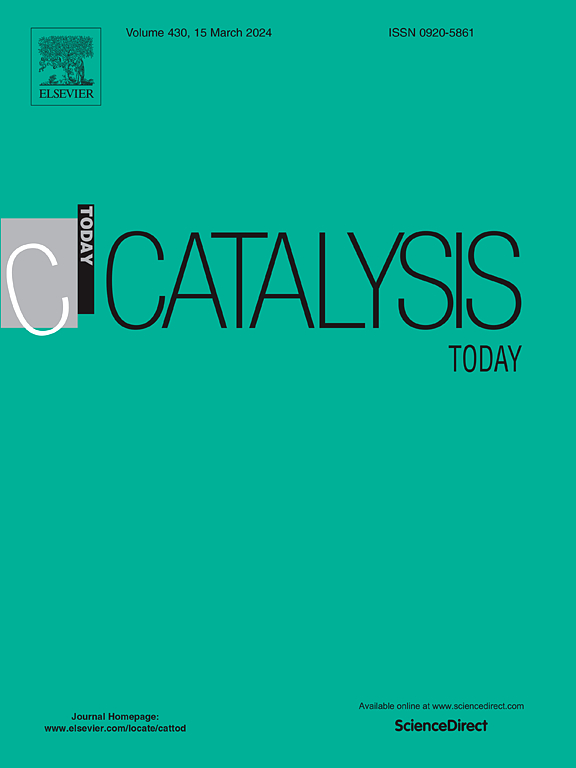Photothermal activation of methane dry reforming on perovskite-supported Ni-catalysts: Impact of support composition and Ni loading method
IF 5.2
2区 化学
Q1 CHEMISTRY, APPLIED
引用次数: 0
Abstract
The Dry Reforming of Methane (DRM) is an intriguing process to convert two greenhouse gases, CH4 and CO2, into syngas (CO+H2) and to upgrade biogas into biosyngas. However, the challenges of high operating temperatures and catalyst deactivation have hindered its large-scale implementation so far. Recently, photothermal catalysis has emerged as a sustainable alternative to conventional thermocatalysis, enabling a reduction of the required temperature and improvement of catalyst stability. This approach necessitates the development of a suitable photocatalyst. Herein, we proposed the use of active Ni nanoparticles (NPs) with plasmonic features, supported over semiconductive perovskites LaFeO3 or LaMnO3 with La-deficiency. The incorporation of Ni was achieved through either B-site substitution within the perovskite lattice or surface loading via Ammonia Deposition Precipitation (ADP), followed by a reductive treatment under H2 to yield Ni0 NPs. The prepared samples were extensively characterized by XRD, N2 physisorption, H2-TPR, SEM-EDX, HAADF STEM-EDX, XPS, UV-Vis DRS. The pre-reduced catalysts were then tested for thermal and photothermal DRM under visible light illumination (3 suns) at 600 °C. The Fe-based samples were poorly active because of Ni0 reoxidation, whereas a good activity and stability were ensured by Mn-perovskites, preserving the Ni0 active species. Among the Ni loading procedures, only ADP ensured improved activity in photothermal conditions thanks to high Ni NPs concentration, while the B-site doped catalyst showed better thermal than photo-activity because of low surface Ni concentration. Interestingly, light illumination was found to reduce perovskite decomposition and coke deposition. A Ni/Al2O3 reference catalyst demonstrated slightly higher activity than Ni/LaMnO3 but suffered from much faster deactivation due to coking and reoxidation.
钙钛矿负载Ni催化剂上甲烷干式重整的光热活化:载体组成和Ni负载方式的影响
甲烷干重整(DRM)是一个将两种温室气体CH4和CO2转化为合成气(CO+H2)并将沼气升级为生物合成气的有趣过程。然而,到目前为止,高温和催化剂失活的挑战阻碍了其大规模实施。最近,光热催化已成为传统热催化的可持续替代品,可以降低所需的温度并提高催化剂的稳定性。这种方法需要开发一种合适的光催化剂。在此,我们提出使用具有等离子体特征的活性Ni纳米颗粒(NPs),支撑在半导体钙钛矿LaFeO3或LaMnO3上。Ni的掺入是通过钙钛矿晶格内的b位取代或氨沉积沉淀(ADP)的表面负载来实现的,然后在H2下进行还原处理以产生Ni0 NPs。采用XRD、N2物理吸附、H2-TPR、SEM-EDX、HAADF STEM-EDX、XPS、UV-Vis DRS等手段对制备的样品进行了表征。然后在600°C的可见光照射(3个太阳)下测试预还原催化剂的热和光热DRM。由于Ni0的再氧化,铁基样品的活性较差,而mn -钙钛矿则保证了良好的活性和稳定性,保留了Ni0活性物质。在Ni负载过程中,由于Ni NPs浓度高,只有ADP在光热条件下保证了活性的提高,而b位掺杂催化剂由于表面Ni浓度低,热活性优于光活性。有趣的是,光照可以减少钙钛矿的分解和焦炭的沉积。Ni/Al2O3参考催化剂的活性略高于Ni/LaMnO3,但由于焦化和再氧化,其失活速度要快得多。
本文章由计算机程序翻译,如有差异,请以英文原文为准。
求助全文
约1分钟内获得全文
求助全文
来源期刊

Catalysis Today
化学-工程:化工
CiteScore
11.50
自引率
3.80%
发文量
573
审稿时长
2.9 months
期刊介绍:
Catalysis Today focuses on the rapid publication of original invited papers devoted to currently important topics in catalysis and related subjects. The journal only publishes special issues (Proposing a Catalysis Today Special Issue), each of which is supervised by Guest Editors who recruit individual papers and oversee the peer review process. Catalysis Today offers researchers in the field of catalysis in-depth overviews of topical issues.
Both fundamental and applied aspects of catalysis are covered. Subjects such as catalysis of immobilized organometallic and biocatalytic systems are welcome. Subjects related to catalysis such as experimental techniques, adsorption, process technology, synthesis, in situ characterization, computational, theoretical modeling, imaging and others are included if there is a clear relationship to catalysis.
 求助内容:
求助内容: 应助结果提醒方式:
应助结果提醒方式:


